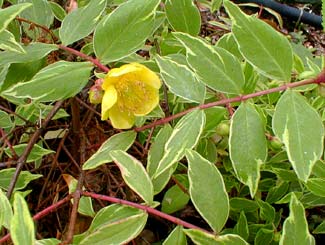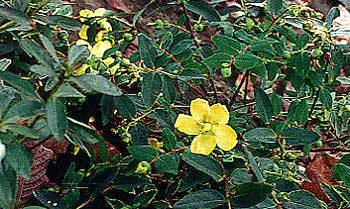 Moser's Saint John's Wort
Moser's Saint John's Wort
"How well the skilful gardener drew
Of flowers & herbs this dial new!
Where, from above, the milder sun
Does through a fragrant Zodiack run;
And, as it works, th' industrious Bee
Computes its time as well as we.
How could such sweet & wholsome Hours
Be reckon'd but with herbs and flow'rs!"
-Andrew Marvel
(1621‚1678)
(1621‚1678)
We have four varieties (three species) of Saint John's Wort growing under a very old & large overhanging choke cherry.
This is a great deal more shade than is usually recommended. Nevertheless, both Hypericum 'Hidcote' & the H. androsaemon 'Glacier' seem 100% happy with only dappled sunlight. Our several clumps of three varieties of Moser's St. John's Wort (H. moseranum) are also doing well in the shade, but do not bloom as mightily as the 'Glacier' & 'Hidcote,' so that I suspect the Mosers cultivars would increase in floweriness if I were to move them to the sun.
They've done well enough where they're at for a few years already, however, & I'm not about to move them. I've never actually had the opportunity to compare, but my suspicion is they would produce more flowers at one time, but not bloom quite so long throughout the year, if I gave them the generally recommended sunny & therefore less protected location. In their protected location they flower off & on from summer through winter's end.
 Our two varieties of H. moseranum are 'Tricolor' shown in the first photo above (from June 2003), & shown in the second photo snapped a couple autumns earlier, 'Gold Flower.'
Our two varieties of H. moseranum are 'Tricolor' shown in the first photo above (from June 2003), & shown in the second photo snapped a couple autumns earlier, 'Gold Flower.''Gold Flower' doesn't have 'Tricolor's' variegated leaf but is otherwise the same. The Gold has leaves green on top & blue-green underneath, & red twigs. The red twigs are visible in both portraits, but especially in the 'Tricolor' portrait. Both varieties have bright gold-yellow flowers appearing singly or in clusters.
Moser Hypericums are not a wild species, but are the Chinese H. patulum hybridized with the North African & Central Asian H. calycinum. The latter is a creeping groundcover often called "Aaron's Beard" instead of "Creeping St. John's Wort." Because that species remains so close to the ground, its genetic component causes the hybrids to remain smaller than H. patulum by a third, & could be regarded as dwarf forms.
The hybrid cultivars are vastly more restrained than either of the two species subshrubs, which can be aggressive. They may even be "too" restrained, since in this mixed group of hypericums they can appear awfully subdued compared to the 'Hidcote' & 'Glacier.' As with the species shrubs, though, H. moseranum cultivars thrive in dry poor soil whether in sun or moderate shade.
The yellow flowers of H. moseranum have tufted stamins. These appear at first tepidly in mid Spring & continue so long into winter they almost seem like year-round bloomers. The portrait at the top of the page was taken in mid-September (2001), but in December there were even more blossoms to be seen, & not until February or March did they have a break in their bloom cycle & wait till the end of April to start up again with a very few blooms, then many blooms by early June. There is sometimes a "quietening" of the blooms in August, but otherwise it is flowering from June to February. This ever-blooming capacity might not be achieved in less temperate areas, or less protected spots even here on Puget Sound; & even though 'Hidcote' & 'Glacier' are more impressive shrubs in all, only these Moser hybrids approach ever-blooming.
These cultivars are restrained plants that do not become invasive as do some varieties of St. John's Wort. They are small twiggy evergreens one to two feet tall. If not occasionally trimmed back, they can cease to leaf well at the center, nor will they bloom as well since they bloom in new twigs only. Very late winter or early spring, then, it is essential to trim them back quite a lot to keep them more compacty leafed & flowerful.
If you look closely at the second picture ('Gold Flower') you'll see some red leaves on the ground underneath the twigs. These are from the main overhanging trees which automatically mulch the garden come autumn. I just have to knock the falling leaves off the heads of the various plants but otherwise leave them right there to protect the crowns of all the plants in this garden. These are leaves of the choke cherry & of an old Japanese maple.
Other things growing underneath & between these trees include native gingers, azaleas including 'Purple Splendor,' three species of cyclamens, a large clump of an evergreen iris (I. foetidissima), & a miniature dogwood groundcover called bunchberry which I just love the dickens out of because a patch of bunchberry looks like a six or eight inch tall dogwood forest.
St. John's Wort is named for John the Baptist of Christian gospels. Where the gospels say that John lived in the wilderness eating only insects & wild honey, the Greek word for insects or locusts, akron, might not have meant only insect, but a flower to which locusts were attracted. A legend arose that John the Baptist was actually quite the gourmet cook, & had his locusts dipped in honey & served with the plant that is named in his honor.
More Saint John's Wort legends are illuminated on the page about the Hidcote variety.